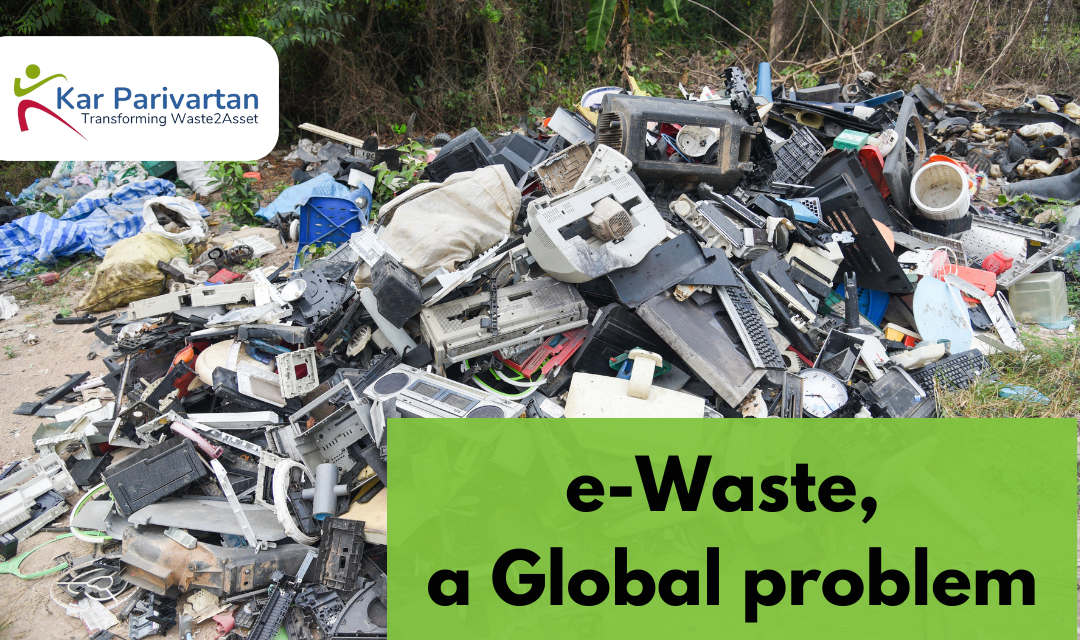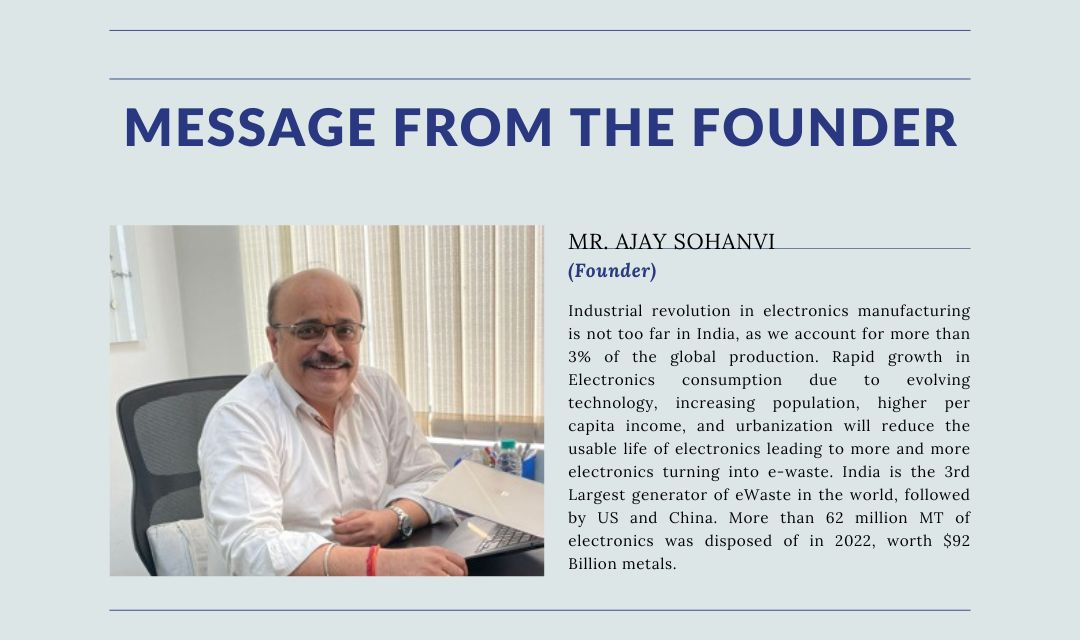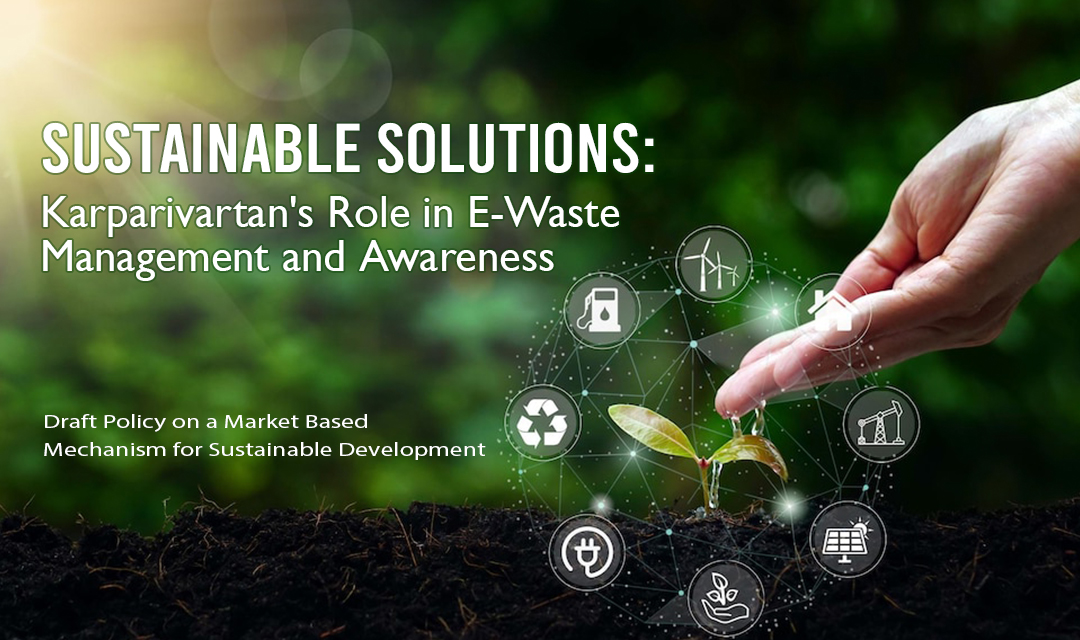Immersing in Nature's Symphony
e-WASTE
When electronic products comes to the end of their life, they become waste. E-waste, or electronic waste, encompasses electrical and electronic equipment that’s outdated, unwanted, or broken. That means everything from smartphones to end-of-life refrigerators. Basically, anything that runs on electricity that you’ve decided to get rid of. Globally, the term associated with eWaste is also known as WEEE (Waste Electrical & Electronic Equipment). E-waste is one of the fastest-growing waste streams on the planet.
Globally, we only recycle 10% of our e-waste, and remaining 90% we don’t recycle, it ends up getting landfilled, incinerated, or illegally traded.
Global Overview
The Global E-waste Monitor 2020 (www.globalewaste.org), a record 53.6 million metric tonnes (Mt) of electronic waste was generated worldwide in 2019, up 21 per cent in just five years, 7.3 kg per capita, it is projected to grow to 74.7 Mt by 2030, almost a doubling of e-waste in just 16 years. This makes e-waste the world’s fastest-growing domestic waste stream, fuelled mainly by higher consumption rates of electric and electronic equipment, short life cycles, and few options for repair. Only 17.4 per cent of 2019’s e-waste was collected and recycled.
According to the Global E-waste Monitor 2020, nearly 78 countries adopted the e-waste policy, regulation, and legislation. Even though most developing countries adopted policy, regulation, and legislation to regulate e-waste, they still lack proper systematic e-waste collection and management methods. As per the report, Asia generated the greatest volume of e-waste in 2019 — some 24.9 Mt, followed by the Americas (13.1 Mt) and Europe (12 Mt), while Africa and Oceania generated 2.9 Mt and 0.7 Mt respectively. For perspective, last year’s e-waste weighed substantially more than all the adults in Europe, or as much as 350 cruise ships the size of the Queen Mary 2, enough to form a line 125 km long.
53.6mt global e-waste consists of precious raw materials such as aluminum, copper, iron, gold worth the value of $57 billion USD. Only $10 billion USD value of raw materials (4 Mt) retrieved from properly documented recycled e-waste amounts to only 17.4% (9.3 Mt) of global e-waste. The remaining 82.6% (44.3 Mt) of e-waste is dumped into the environment without proper documentation and recycling management. Therefore, recycling companies play a vital role in processing and managing undocumented e-waste. Proper management of e-waste not only gives enough returns but also protects the environment and health of the people.
Statistics show that Asia generated the highest quantity of e-waste.
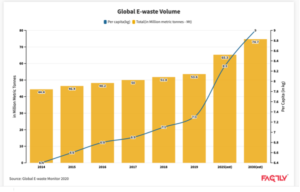
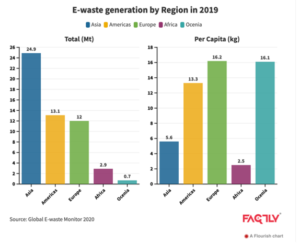

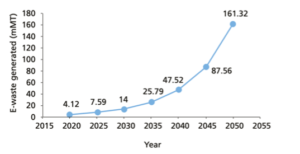
E-Waste management rules in India
Dominance of informal sector, health & environment pushed to lead and draft eWaste management rules in India. It is important to know that India is the only country in Southern Asia with e-waste legislation since 2011. The Government has also notified E-waste (Management) Rules, 2016 , to ensure E-waste is managed effectively. A manufacturer, dealer, Refurbisher and Producer Responsibility Organization (PRO) were also brought under the ambit of these Rules. PRO is a professional organization authorized or financed collectively or individually by producers, which can take the responsibility for collection and channelization of e-waste. Furthermore, the applicability of the Rules was expanded to cover components, consumables, parts and spares of EEE in addition to the equipment’s covered under the Rules.
Few of the key objectives of these rules include:
Extended responsibility to producers to manage a system of E-waste collection and channelization through Extended Producer Responsibility (EPR) Authorization.
- To promote and encourage establishment of an efficient e-waste collection mechanism
- Promote environmentally safe & sound recycling by channelizing E-waste to authorized dismantlers and recyclers of E-waste
- To minimize illegal recycling/recovery operations
- Reduce Hazardous substances in Electrical and Electronic components
Hence, in view of the potential hazards that E-waste could cause to nature, as well as the opportunity to recycle precious metals (thus reducing exploitation of nature), it is of paramount importance that the countries world over (including India) ramp up their infrastructure and streamlines the process for better tracking & recycling of e-waste.
In order to successfully handle e-waste, coordination with other stakeholders from industry, government, NGOs, international organizations, and academia is required. Some of the principles to develop effective e-waste management systems are to set a clear legal framework for e-waste collection and recycling, to enable the producers to finance the collection and recycling of e-waste under EPR, to strengthen the monitory and compliance mechanisms, to provide an incentive for recyclers to enhance in systematic and technological advancements. To create awareness among consumers about the environmental benefits of recycling, to create awareness among the workers about the health hazards of working in recycle management centres, and to provide them with frequent medical support.
How Covid-19, will impact in future growth of eWaste?
Technology investment in beginning of the pandemic will add to growing concern of e-waste. The transition of remote working or work from home spurred on a wave of new device purchases. Organisations invested in new equipment to enable their employees to work from home. Schools, institutions and students invested on technology and devices to facilitate distance learning. In fact, demand of sourcing new technology became one of the top priorities to keep people safe, distanced and protected.
Why is e-waste so bad?
E-waste contains a various chemicals that are harmful to people and our environment, like: mercury, lead, beryllium, brominated flame retardants, and cadmium, i.e. and when this eWaste is mishandled during disposal, these chemicals end up in our soil, water, and air contaminating are natural resources, health and environment. Some of the key challenges associated with eWaste, if it goes to landfill are:
1. WEEE can cause fire.
2. Cause pollution and raise health problems.
3. Rare elements, are lost with resource recovery.
4. Limitation to Regulatory compliance.
What are the reasons of growing eWaste problem?
The main reasons for growing eWaste problems are :
1. Awareness : Lack of knowledge and consumer behaviour among consumers on eWaste impact
2. Policy Penetration: While there are efforts in policy formulation, but associated challenges on implementation add to the problem.
3. Gaps in Capacity and Capability: Limitation in industrial infrastructure to recycle eWaste, while there are efforts to enhance the capability to meet the growing demand.
4. Collection and Channalisation of eWaste : Limitation in availability of appropriate collection channel, against the informal sector capability.
5. Incentives & Promotions : Limitations in clarity of incentives to industry and consumers in the development of ethical ewaste management.
What can we do about it?
Be Aware, and by being more mindful about where your e-waste ends up, you can limit how much you produce and the impact it has on the environment. The concept of 4R, needs to be considered to help, save our planet and our wellbeing. The 3R, concept includes Reduce, Reuse, Repair and Recycle.
Reduce: The easiest way to solve the e-waste crisis is to produce less e-waste. Be wise, when you buy EE equipment’s and a right decision between necessity and luxury to limit the acquisition. Also, by taking care of your electronics you can ensure that they last longer to save money and our environment too.
Reuse: If, your EE equipment is working fine but may not be in use then consider regifting, selling, or donating it. Your waste, may be an asset for someone else.
Repair: We generally, throw out and replace broken electronics instead of getting them repaired. The opportunity of repair, may be with you or with someone else. This may help limiting the eWaste further.
Recycle: Lastly, you can always recycle your e-waste—just make sure you’re doing it correctly and through ethical channel to help save our environment. The eWaste should not be given to informal sector, who lacks capability and capacity in the recycling of eWaste.
Benefits of Recycling
1. Protects the environment – Recycling e-waste can keep a range of harmful materials out of the environment.
2. Extracted material can be reused in manufacturing new EE equipment’s delivering circular economy.
3. Saves, landfill Space – Reduced impact on Urban Local Bodies to manage the landfills.
4. Saves, natural resources – natural resources such as metals aren’t wasted and the energy and cost required to manufacture and mine them are also saved.
5. Increased Employment – By recycling e-waste, several people get a job. More jobs mean financial stability for our people.
6. Increased Affordability – Reduced cost of manufacturing due to recycled material will increase affordability.
7. Promotes mindful consumer approach based on 4R principle.
To know more on eWaste and how to manage effectively, do write to us on: info@karparivartan.com.

